Kristin Holt's Blog, page 30
February 28, 2016
Victorian Leap Year Traditions, Part 2
February 27, 2016
Victorian Leap Year Traditions, Part 1
February 25, 2016
Nineteenth Century Mail-Order Bride SCAMS, Part 6
February 22, 2016
Nineteenth Century Mail-Order Bride SCAMS, Part 5
February 19, 2016
Nineteenth Century Mail-Order Bride SCAMS, Part 4
February 16, 2016
Nineteenth Century Mail-Order Bride SCAMS, Part 3
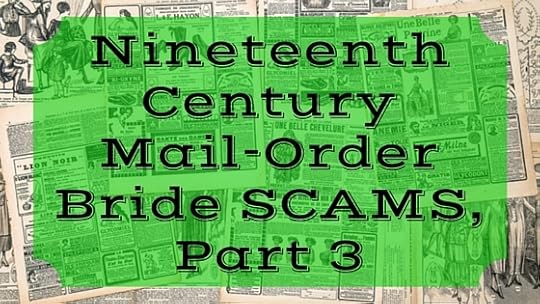
Nineteenth Century Mail-Order Bride SCAMS, Part 3, wherein a man with two wives (neither knows about the other) seeks yet two more… entirely to swindle them of their means. This article may appear lengthy (10 separate snippets), but it’s so well worth a read. “Franks”, as he presents himself on the West Coast, in the middle of defrauding women through multiple marriage agencies is scammed, himself, by a “wealthy widow” in demand of a expensive courtship. [Amateur historians will find myriad details worth noting, such as the communication of chiefs of police, use of the term ‘dead beat’, laws on the books, and so much more.]

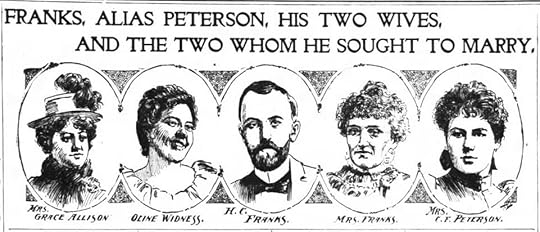
San Francisco Chronicle, 29 January 1899. Image included with article header.
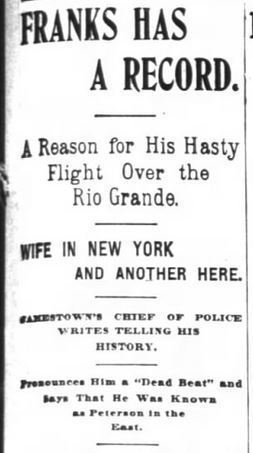
San Francisco Chronicle. 29 January, 1899. Part 2 of 10.
Note: The article is a bit difficult to read in places, as the 116 year-old images either did not scan well or had faded beyond the ability to do so. With a bit of patience it is readable…and the story told within is so worth understanding. I urge you to read it all!
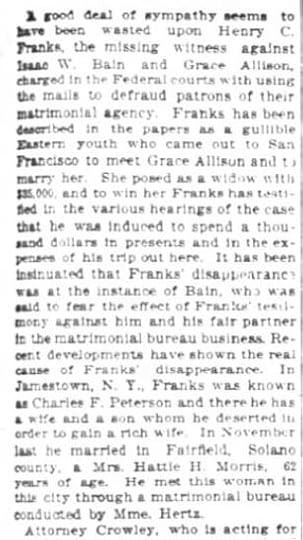
San Francisco Chronicle. 29 January, 1899. Part 3 of 10.
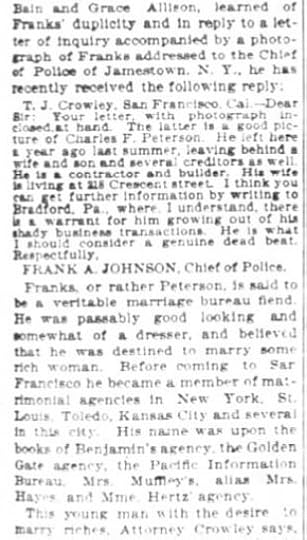
San Francisco Chronicle. 29 January, 1899. Part 4 of 10.
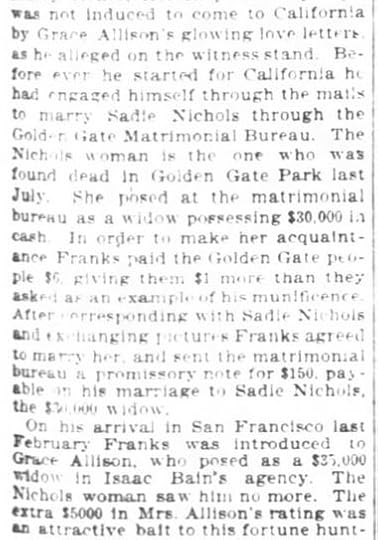
San Francisco Chronicle. 29 January, 1899. Part 5 of 10.
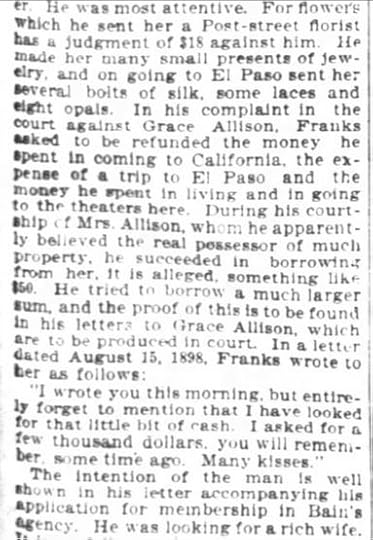
San Francisco Chronicle. 29 January, 1899. Part 6 of 10.
Note: See in the above section that Franks had borrowed something like $50…then attempted to borrow a much larger sum. Today, $50 is a good chunk of change but not the end of the world. According to an inflation calculator, $50 of 1898 dollars would be worth: $1,428.57 in 2015 (calculator does not extend to 2016). Okay…Almost $1500 is a lot of money.
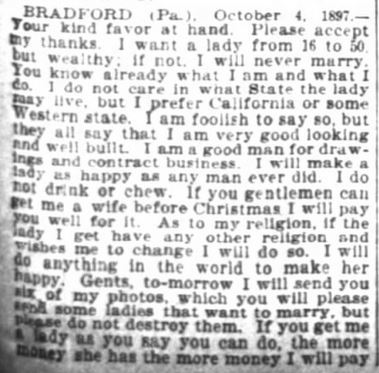
San Francisco Chronicle. 29 January, 1899. Part 7 of 10.
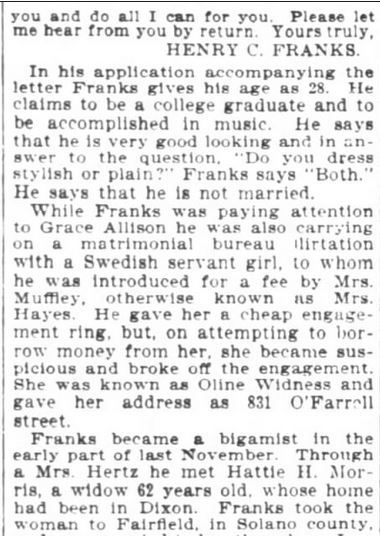
San Francisco Chronicle. 29 January, 1899. Part 8 of 10.
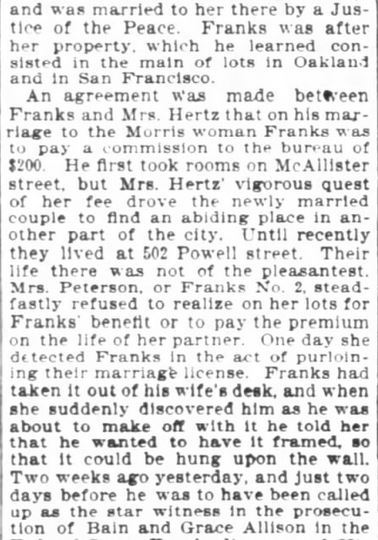
San Francisco Chronicle. 29 January, 1899. Part 9 of 10.
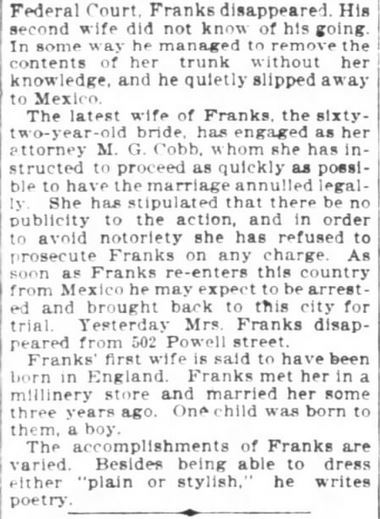
San Francisco Chronicle. 29 January, 1899. Part 10 of 10.
Amazing, isn’t it? One man, using multiple matrimonial bureaus and agencies to defraud multiple women of their property, finds himself scammed in the midst of it all by a woman demanding an expensive courtship. The only bright one in their midst appears to be the Swedish Serving Girl who broke off an engagement with the man when he requested to borrow money from her.
Today’s women could take a lesson from her, don’t you think?
Please– scroll down and leave a reply! And please forward this article to those you know who may find it interesting.
Note: Newspaper clippings were obtained from newspapers.com.


Image: Depositphotos, Copyright AnSim, used per standard agreement
Up Next! Nineteenth Century Mail-Order Bride SCAMS, Part 4. In 1865 (34 years earlier than Franks’ scheme), a similar incidence in New England didn’t get quite so far but caused quite a stir.
Nineteenth Century Mail-Order Bride SCAMS, Part 1 Nineteenth Century Mail-Order Bride SCAMS, Part 2 NEWSPAPER Brides vs. Mail-Order Brides Mail-Order Catalogs: Timeline & Truth Mail Order Brides in the 19th Century American West Book Review: Hearts West: True Stories of Mail-Order Brides on the Frontier, by Chris Enss
Copyright © 2016 Kristin Holt, LC
.
February 13, 2016
Victorian Era Valentine’s Day
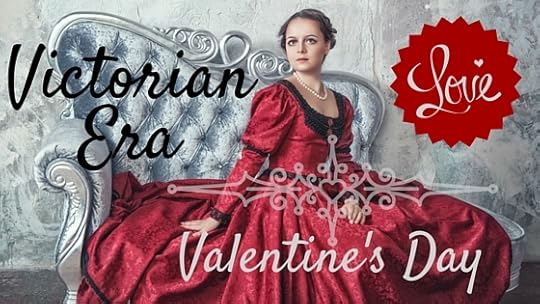
The Victorian Era was a time of Romanticism: flowery language, love letters as a part of courtship; the protection of sweethearts, wives, and mothers and sheltering beloved females from the coarser realities of the world. Courtship involved the wooing of a special woman often through poetry, written expressions of tender feelings, and just the right turn of phrase in conversation.
HISTORY
In America’s Victorian Era, observing Valentine’s Day was an important and significant holiday. Newspaper accounts throughout the decades often recall the ancient Roman history of Valentine’s Day, including the origin of the name, customs, and more. The following article is representative of many present throughout the era’s papers, citing English and Scottish historical traditions of pairing (first both married and unmarried, then in the last few centuries, unmarried only) males and females:
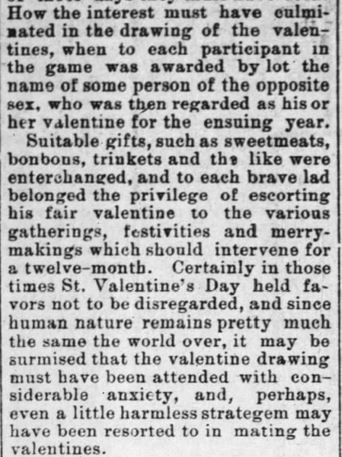
Old Valentine Pairing. The Wilmington Messenger. Friday, February 14, 1890. Likely the tradition that began the time-worn phrase, “Will you be my Valentine?”

LATE NINETEENTH CENTURY
“During the late nineteenth century, the occasion of St. Valentine’s Day was a chance for novelty in entertaining. Valentine’s Day party ideas such as luncheons, teas, socials and fancy dress functions of all sorts were easily and artistically arranged with flowers, hearts, darts and cupids. The success of these pleasant social affairs often depended on the theme of the party.” [Source]
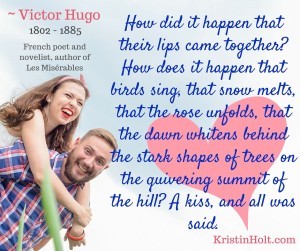
“A token of love in the 19th century was a paper hand, which was a symbol of courtship. Tiny paper gloves were also popular. Real gloves had long been a favorite valentine gift, especially in the British Isles were it became a true love token. With them went verses like this:
If that from Glove, you take the letter G
Then Glove is Love and that I send to thee.
Sometimes the gloves was a way of proposing. If the girl accepted, she wore them to church the following Easter.” [Source]

VALENTINE’S DAY GIFTS
When and where available, and when financial circumstances made such gifts (and frivolities) possible, newspapers of the day indicate sweethearts (particularly ladies… but gentlemen, too) expected Valentine’s Day gifts from the fellow courting them (or their best gal).
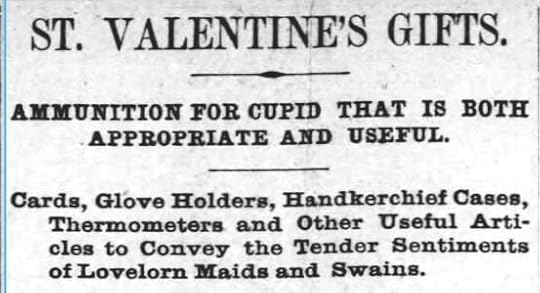
By Special Correspondence from New York, February 5th. St. Louis Post-Dispatch, 8 February, 1891. Article Header.
According to the papers, the list of suitable and appropriate Valentine’s Day gifts include:
Gloves
Decorative glove boxes with inscribed/imprinted love sentiments
Handkerchiefs (decorative)
Decorated hankie boxes with inscribed love phrases and sentiments
Silver trinkets
Thermometers (with an appropriate little poem about no matter the weather, his love is true)
Embroidery scissors
COMMERCIALLY PREPARED PAPER VALENTINES
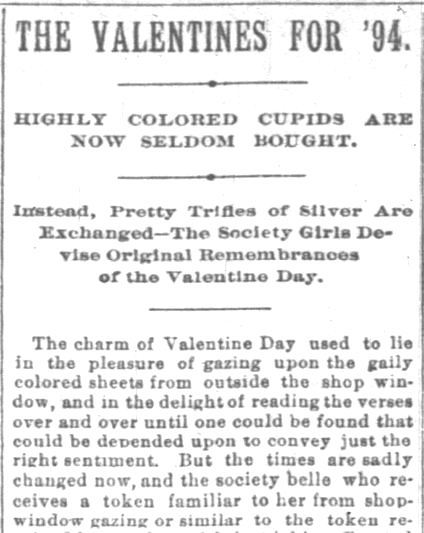
The Indianapolis News. Indianapolis IN. 10 February 1894. The Valentines for ’94. “Original Cards Only”. Part 1 of 3
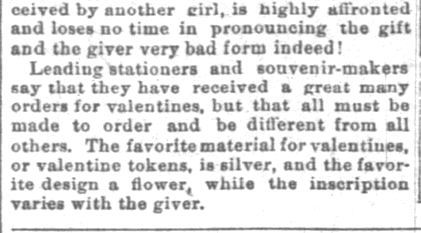
The Indianapolis News. Indianapolis IN. 10 February 1894. The Valentines for ’94. “Original Cards Only”. Part 2 of 3
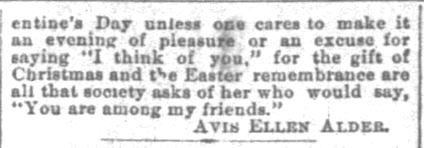
The Indianapolis News. Indianapolis IN. 10 February 1894. The Valentines for ’94. “Original Cards Only”. Part 3 of 3

Apparently Valentines (sweethearts) became a bit more choosy later in the century. The ad, above, is from 1894. The one, below, comes from 1869 when commercially prepared paper valentines were popular and commonplace. And apparently not required to be highly personalized and unique in order to please the recipient.
Valentine cards could be mailed (and the decorum books and pamphlets of the era focus in the necessity of good manners in mailing the card postage paid rather than expecting the object of your affections to pay the postage upon delivery and to take care to post it) so the delivery was made on Valentine’s Day. Apparently more mail was delivered for Valentines than for Christmas in the late Victorian era.
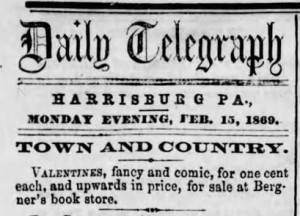
Valentines for Sale. Harrisburg Telegraph, Harrisburg, PA. 15 February, 1869.
Ready-made paper valentines were available from early in the 19th century. The advertisement, above from 1869 shows a book store by the name of Bergner’s offering Valentines (both fancy and comic) for one cent each (and upwards in price). By 1889 (20 years later), the average paper valentine cost $5 each… on ‘clearance’, after hours on the 13th. What on earth did the commercial paper valentine cost on the 10th of February (enough time to postmark it to your favorite gal)?
Remember the inflation calculator I offered some time ago in a blog post? That $5 in 1889 is equivalent to $131.58 in 2015. OUCH.
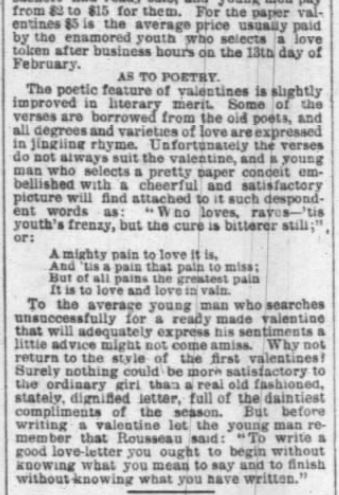
From the Chicago Daily Tribune, Thursday, 14 February 1889, pg 9. The average cost of a paper Valentine, the purpose and necessity of poetry, and strong recommendation for a genuine Love letter.
“To write a good love-letter you ought to begin without knowing what you mean to say and to finish without knowing what you have written.” ~Rousseau (quoted from the article, immediately above, from the Chicago Daily Tribune, 14 February 1889, page 9)

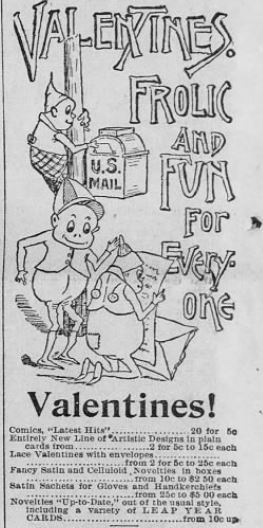
Valentines Advertisement. Note the inclusion of Leap Year cards in the ad. The San Francisco Call, published 9 February 1896.
OLD WEST AND VALENTINES
But what about the Old West? The newspaper articles cited above are from San Francisco, Chicago, and points further east… but late enough the “Old West” was quite civilized, the transcontinental railway had linked the west coast to the rest of the union, and such things as commercially made valentines were available for purchase.
What was available to a man lucky enough to have a wife or sweetheart in the far reaches of frontier America?
Courting Gifts of his own manufacture (wooden carving, a new piece of finely crafted furniture made with his own carpentry skills, even a small painting or sketch, a hand-written poem of his own creation, a pair of hand-sewn leather gloves, and many more options)
A betrothal gift of family heirloom (a ring from great grandmother, for example)
A carefully written love letter in his best penmanship as expert handwriting was seen as an art form all of its own
a handmade greeting card put together with anything at his disposal–knowing ladies like frills and lace and ribbons, maybe even containing such extravagances available at most of the earliest country stores.
If the years were far enough advanced [1894!]to have access to a mail-order catalog (and the hard cash to make a purchase), jewelry, hat-pins, watch-pins, chains, rings, etc. Anything a man could want to buy his sweetheart was pretty much available.
Anything at all his Valentine needs… if he can get his hands on it. The Bride Lottery is set in a mining camp a hard stagecoach ride above Leadville, Colorado, in 1881. Sam owns the mercantile and as the arranged-for brides arrive, he stocks his store with courting gifts–anything the miners might want to buy for their gals. But he ends up giving Evelyn fabric to sew herself practical clothing that fits (as her girth is expanding). He’s a bit embarrassed by his decision for a courting gift (though it’s not Valentine’s Day). After all, how does a man admit his sweetheart needs bigger clothing with offending her tender sensibilities? [A deleted scene, in its entirety, is set in the store… and shows (among other things) the miners perusing the courting gifts.]
What would you add to these lists?
I’d love to hear what you think. Please scroll down and post a reply in the space offered.


Image: Depositphotos, Copyright AnSim, used per standard agreement
Up next! Nineteenth Century Mail-Order Bride SCAMS, Part 3, wherein one married man (with two wives who don’t know a thing about one another) seeks to snare two more…entirely for financial gain.
Nineteenth Century Mail-Order Bride SCAMS, Part 1 Nineteenth Century Mail-Order Bride SCAMS, Part 2 Victorian New Year Celebrations, on Sweet Americana Sweethearts A Victorian Menu for New Year’s Day, 1892 American Victorian Era Christmas Celebrations Victorian Era Thanksgiving Celebrations
Copyright © 2016 Kristin Holt, LC
.
February 10, 2016
Nineteenth Century Mail-Order Bride SCAMS, Part 2
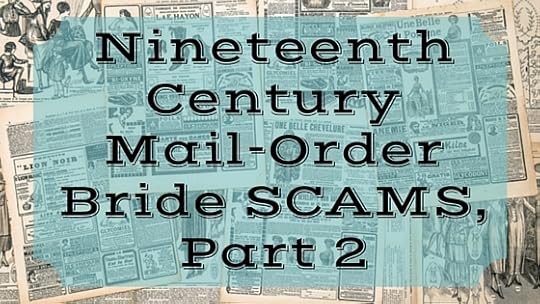
I believe FACT is stranger than FICTION.
And often the BEST fiction is solidly founded in FACT. Hence my keen interest in the truth of Matrimonial Agencies, Matrimonial Personal Advertisements, and real-life stories of couples connected through the mail in the nineteenth Century.
NO ONE ABOVE SUSPICION
This one is bizarre. Don’t most of us want to believe that clergy are above reproach? That all ministers and preachers and pastors and priests are completely honest and exactly what they seem to be?
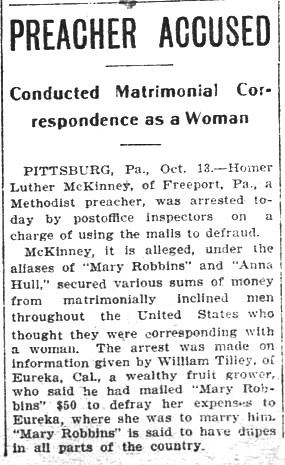
Preacher Accused of Conducting Matrimonial Correspondence as a Woman. Published in The Saint Paul Globe. Saint Paul, Minnesota. 14 October, 1904.
MONEY-MAKING SCAMS
This newspaper story comes from The Times-Democrat, a New Orleans, Louisiana Newspaper from Sunday, 24 April 1887. This scam had me riveted. It reads like fiction!
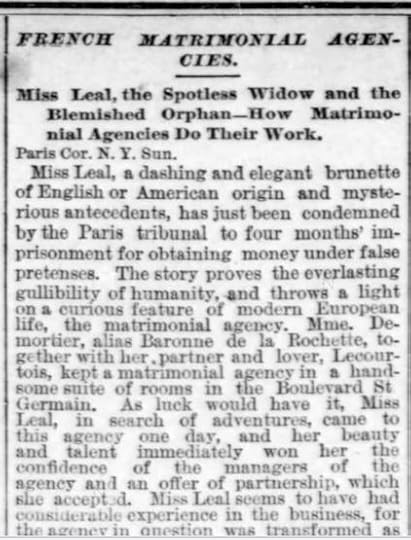
The Times-Democrat. New Orleans, LA. 24 Apr 1887, Sunday. Miss Leal AND Mail Order Bride scam.
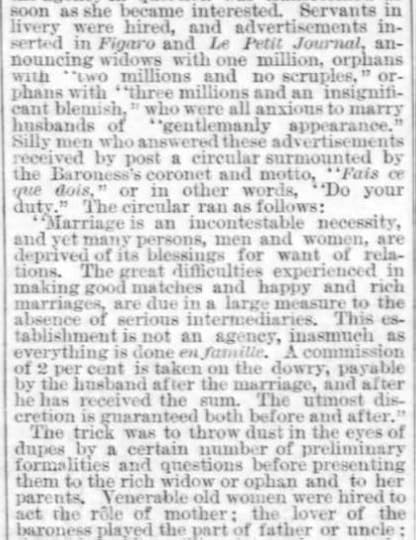
Miss Leal Scam, Part 2
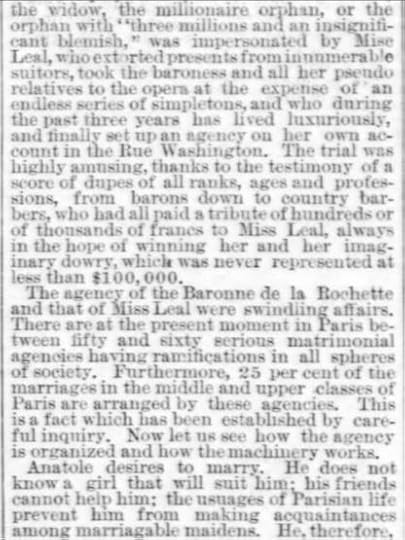
Miss Leal Scam, Part 3
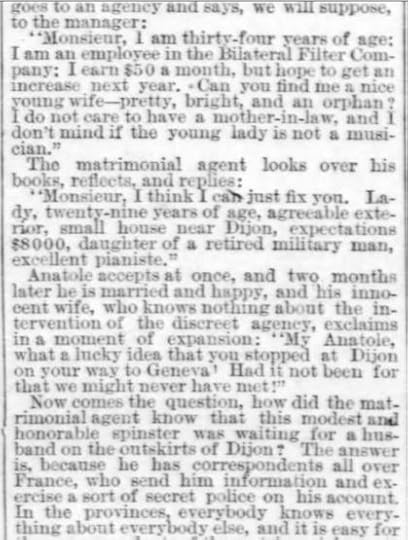
Miss Leal Scam, Part 4
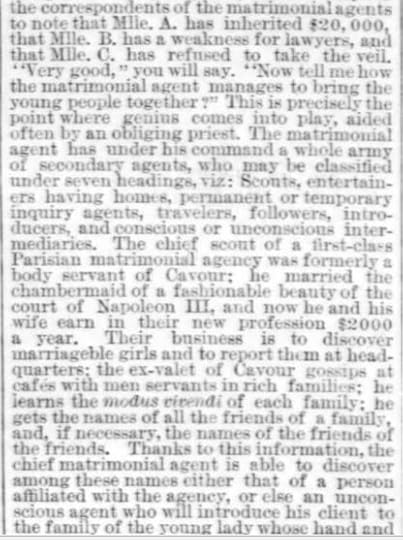
Miss Leal Scam, Part 5
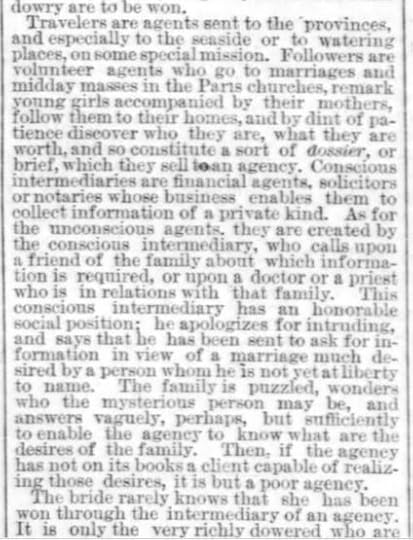
Miss Leal Scam, Part 6
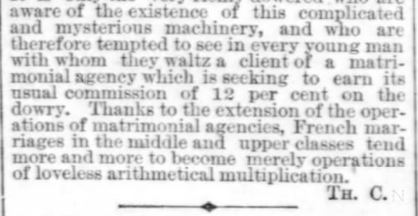
Miss Leal Scam, Part 7 (final)

A separate scam, reported in The Herald and Torchlight, Hagerstown, Maryland, 6 August, 1873 wherein lovely correspondence gives way to blackmail and financial extortion.
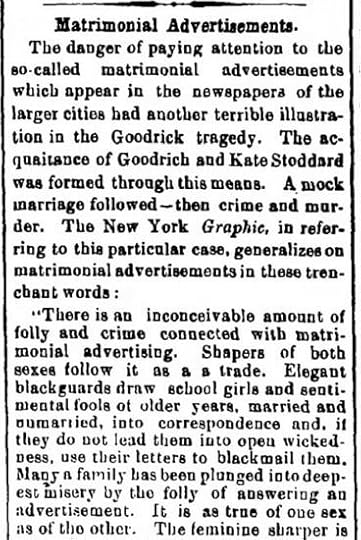
Article reported in The Herald and Torchlight, Hagerstown, Maryland. 6 August, 1873. Part 1 of 2.
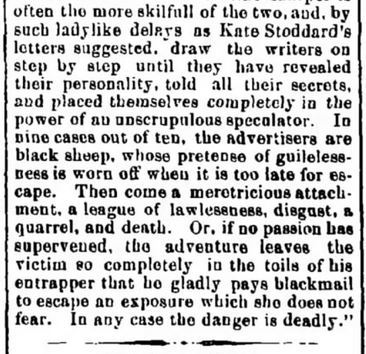
Article reported in The Herald and Torchlight, Hagerstown, Maryland. 6 August, 1873. Part 2 of 2.
Are you as shocked by the lack of decency in the nineteenth century “Love By Mail” segment as I am? I’m appalled so many preyed upon others during a time so many see as gentler, more refined, exquisitely mannered. It seems cads have always existed and if a system exists, crooks will exploit others through it.
What are your thoughts on the matter?
Please share this article with anyone you know who would find the content interesting. Thank you!
Note: Throughout this Article, all newspaper clippings/references were obtained from newspapers.com.


Image: Depositphotos, Copyright AnSim, used per standard agreement
Coming 2-14-16, Victorian Era Valentine’s Day (traditional nineteenth century observations of the Romantic Holiday)
~ followed by a return to this series (2-17-16), with ~
Nineteenth Century Mail-Order Bride SCAMS, Part 3, wherein a man with two wives (neither knows about the other) seeks yet two more… entirely to swindle them of their means.
Nineteenth Century Mail-Order Bride SCAMS, Part 1 NEWSPAPER Brides vs. Mail-Order Brides Mail-Order Catalogs: Timeline & Truth Related Article: Mail Order Brides in the 19th Century American West Related Article– Book Review: Hearts West: True Stories of Mail-Order Brides on the Frontier, by Chris Enss Sweet Americana Sweethearts Blogspot: WANTED: Midwife Bride
Copyright © 2016 Kristin Holt, LC
.
February 7, 2016
Nineteenth Century Mail-Order Bride SCAMS, Part 1
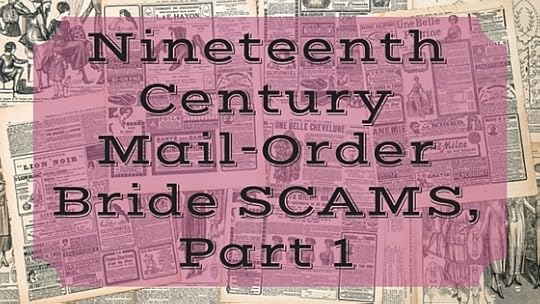
Often, FACT is stranger than FICTION.
This article is Part 1 of a new sequence of blog posts regarding historical facts (mostly from various historical newspapers in the United States) surrounding various scams regarding (what is popularly called) Mail Order Brides, Matrimonial Agencies, long-distance marriage contracts, disreputable persons, and ‘friends’ looking for diversion (a bit of fun and entertainment).
Interestingly enough, readers of Mail-Order Bride-themed Historical Romance aren’t likely to find much in the way of FACTS in the fiction we so love to read.
But that doesn’t mean the true history behind the popular niche isn’t fascinating to those of us who read and write it.

WELL-KNOWN RISKS
My last post addressed the two-sided Public Opinion regarding the idea of seeking a life partner through an agency, a personal advertisement, or some other assistance. That last post cited an article that shed a positive light on the process of a “Mail-Order Bride” (and also debunked the myth that Americans in the last quarter of the 19th Century actually called such arrangements by mail “Mail-Order Brides”–but we’ve agreed to refer to them as such).
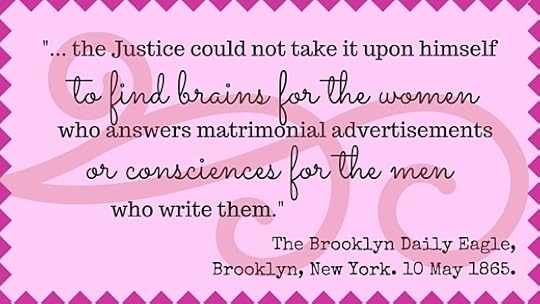
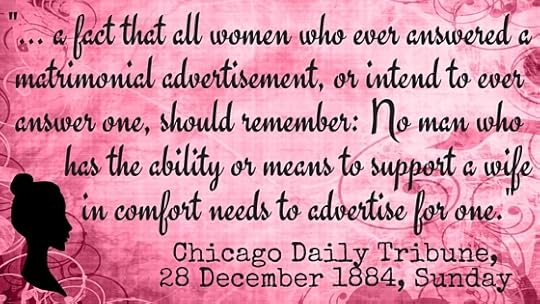
The sheer volume of newspaper accounts spread over decades in virtually every state in the Union and in the Territories containing warnings–of swindled fortunes, disappointed misses, train fare and traveling expenses sent by western grooms to their brides-to-be in New England evaporating into thin air and no bride arriving–make one thing painfully clear. Law enforcement and the average man and women simply had to know the very low public opinion of the whole idea of finding a potential mate through any sort of brokerage, company, or simple personal matrimonial advertisement.
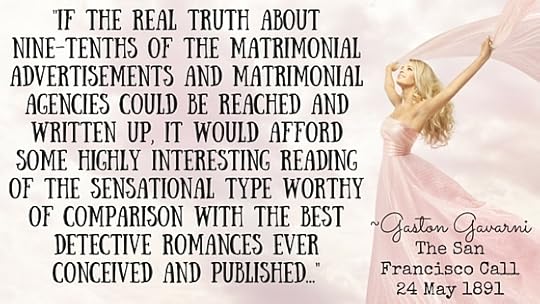
It seems the possibility of finding love (or at least a companionable, legitimate marriage) through a matrimonial service or personal advertisement was slim to none. There must have been an occasional happy story or two because women kept answering advertisements (as did men) and someone (other than newspaper reporters and swindlers) kept writing them.
At the time of Fritz Podzius (editor and publisher of Matrimonial News)’s death in 1916, he’d claimed to have facilitated the marriages of 20,000 couples.
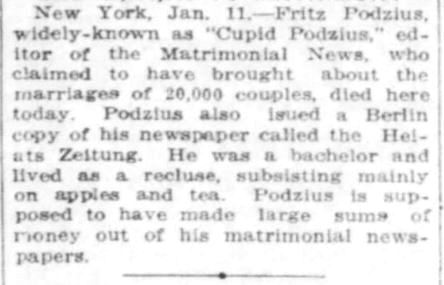
The York Daily, York, PA. 12 Jan 1916. Death notice of Fritz Podzius, and his claim of bringing about 20,000 marriages.

NEWSPAPER REPORTERS
Oh, yes. Newspaper reporters. Whether or not they felt they were exposing crime, shedding light on a growing problem, pointing out the fallacy of youthful hearts engaging in such faulty methods of finding love… their meddling no doubt broke more than one heart and caused more than one young miss serious embarrassment. In studying historic newspapers, I found dozens and dozens of similar articles wherein an investigative reporter (male and female alike) pose as spouse-seeking society-respected adults and enter into a contract with a matrimonial agency or simply post an advertisement in the classifieds, such as the example that follows.
The following example is a portion of an article printed in the Chicago Daily Tribune on Sunday, 28 December, 1884.
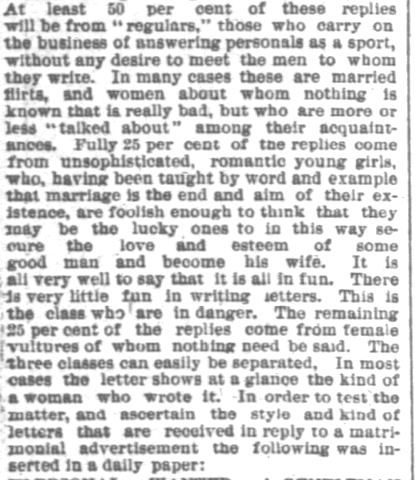
Portion of an article printed in Chicago Daily Tribune on Sunday, 28 December, 1884. (Part 1)
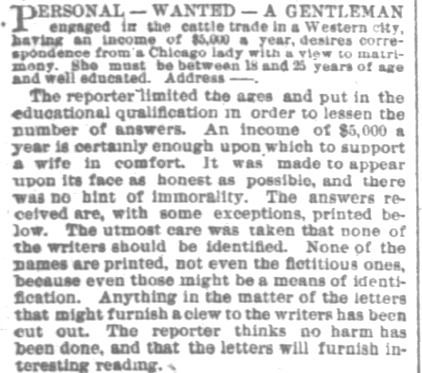
Portion of an article printed in Chicago Daily Tribune on Sunday, 28 December, 1884. (Part 2)
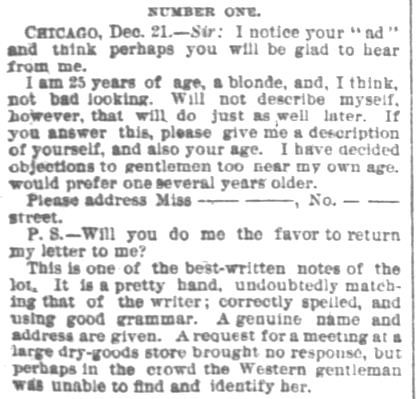
Portion of an article printed in Chicago Daily Tribune on Sunday, 28 December, 1884. (Part 3)
BOREDOM AND ENTERTAINMENT
Some men sought a bride to work beside them on farms and in raising families (little more than an unpaid worker), and some men (obviously bored and seeking entertainment) posted ads as jokes and simply for their own entertainment. Newspapers of the era are filled with anecdotes and stories (probably with a kernel of truth) about men seeking fun by corresponding with hopeful ladies when they had zero intention of offering marriage. An equal accounting of flirtatious women (most of them already wed) carried on correspondences with men they had no intention of meeting. They must have found it diverting. And fun. And perhaps a little naughty.
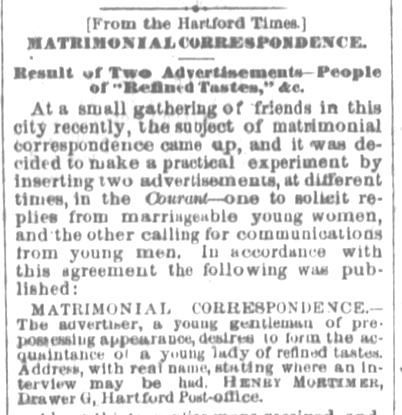
Matrimonial The Cincinnati Enquirer, 18 Oct 1869
PRACTICAL JOKES
Some men’s advertisements apparently originated by someone else entirely. The Matrimonial News found itself embroiled in scandal by not requiring identification or references when allowing men (and women) to provide their name and submit an advertisement, as “friends” often found themselves the brunt of a joke when they received correspondence from hopeful unknown parties. Frequently such practical jokes were played by one friend upon another and apparently never made it to court or involved the law. One such example follows.
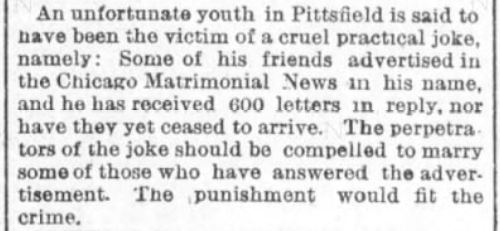
Boston Post, Boston Massachusetts, 16 Feb 1891
If you were the brunt of a practical joke in matters of the heart, would you ever dare risk love again? I know I’d be leery. I can’t imagine (or perhaps I can) what became of the lonely hearts who risked responding to an advertisement only to learn the remarkable-sounding gentleman on the other end of the correspondence was actually a newspaper reporter. Or worse, a woman who didn’t like me and decided to do me harm. I’m interested, and I’m sure all readers are, too. What are your thoughts on this subject? Please respond in the fields provided, below.


Image: Depositphotos, Copyright AnSim, used per standard agreement
Up next! Nineteenth Century Mail-Order Bride SCAMS, Part 2, delving into money-making scams wherein the perpetrators fraudulently relieved the lonely of their hard-earned money. Unfortunately, there are more stories to explore and more methods of defrauding women (and men) to lighten their pocketbooks and poke holes in their dreams.
NEWSPAPER Brides vs. Mail-Order Brides Mail-Order Catalogs: Timeline & Truth Related Article: Mail Order Brides in the 19th Century American West Related Article– Book Review: Hearts West: True Stories of Mail-Order Brides on the Frontier, by Chris Enss Sweet Americana Sweethearts Blogspot: WANTED: Midwife Bride
Copyright © 2016 Kristin Holt, LC
.
February 4, 2016
NEWSPAPER Brides vs. Mail-Order Brides
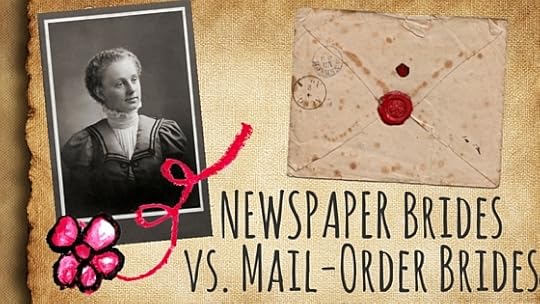
In my previous post, Mail-Order Catalogs: Timeline and Truth, I shared the timeline of United States (and North America)’s Mail-Order Catalog businesses…and the truth behind the familiar term “mail-order”. By 1925, farmers and ranchers in isolated areas would conduct plenty of business by mail and order everything from seed to toilet paper to new dungarees from the Sears, Montgomery Ward, or Bloomingdale’s Catalogs.
Like the brand-to-generic terms we’re familiar with today (e.g., band-aid, kleenex), the familiar term (usually trademarked and properly capitalized) is substituted for the accurate. Adhesive bandage. Tissue. Bride, who happened to have been met and courted through the mail…and found through the newspaper, not a catalog.
![Advertisement for Matrimonial Herald published in the Westminster Budget, London, GB. November 1, 1895. [Image: Newspapers.com]](https://i.gr-assets.com/images/S/compressed.photo.goodreads.com/hostedimages/1454702740i/18003010.jpg)
Advertisement for Matrimonial Herald published in the Westminster Budget, London, GB. November 1, 1895. [Image: Newspapers.com]
Historians generally agree the term “Mail-Order Bride” came about in the language well into the 20th Century…not in time for an accurate portrayal in the 19th Century Mail-Order Bride novels so popular among readers of Western Historical Romance.
Despite the historical inaccuracy, the understood term, throughout the 20th century to the present is “mail-order bride”. So we’ll go with it. Just like everyone understands when I ask for a Kleenex, please (and all they have on hand is the store brand of facial tissue), we all know what “mail-order bride” (with or without the dash) means. So, “mail-order bride” it is.

Advertisement for Matrimonial News. The Des Moines Register, 12 Apr 1873.
Advertisements were published in newspapers far more often than a “catalog” of sorts. In fact more than one Matrimonial-type newspaper started up in the late 19th Century. The Matrimonial News did quite well in London, Germany, and the United States. Some matches were (purportedly) made between impoverished titled British nobility and American heiresses, but many advertising gentlemen admitted to being without land or title, laborers or merchants or home-loving sailors.

Brokered Matrimonial Introductions of the late 19th Century almost always referenced the financial requirements of either party; either how much he/she was worth or the minimum he/she required in a potential match. [Image: Depositphotos, copyright and photo by rrrum; Euro dollar in international currency markets.]
MONEY
Such advertisements almost always included how much money the gentleman sought (or was worth) and how much money the bride-to-be had to her name. Most unromantic, that. I don’t know that I’ve ever read a mail-order bride romance that included the focus on finances. Why? My first guess: it’s not romantic. And fiction should be, ultimately, romantic–after all, we’re talking about Mail Order Bride-trope ROMANCE.
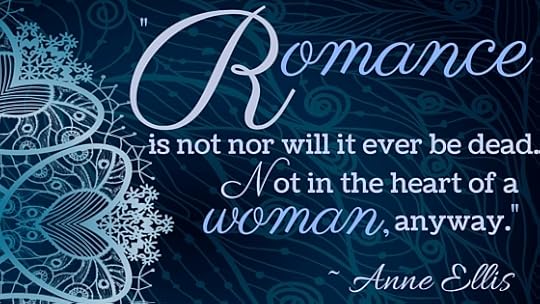
When the matrimonial agency’s introduction brought about a marriage, a strict contract was in force requiring the groom (usually but not always) to pay a percentage of the fortune his bride brought to the marriage. 1% of $10,000 (in the year 1885) seems a pittance to provide to the broker who worked the miracle. Money found its way into the pockets of owners of marriage rags much earlier than at the nuptial celebration. It cost good money to place an ad; in one case reported in a newspaper of the time, the total requested equaled a man’s complete salary for a full five months. He succeeded in bargaining down the required deposit to about 2 and 1/4 months’ salary.
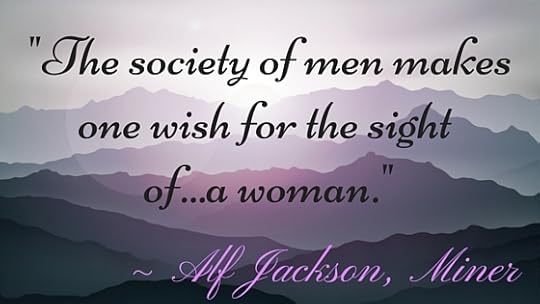
AFFORDABLE INTRODUCTIONS
Given the expense to use a sometimes-trustworthy brokerage, is it any surprise men contacted friends and family “back home” or a preacher they once knew in order to gain an introduction? Personal advertisements were sometimes posted in church newsletters. When trusted friends and family weren’t available, men and women alike placed their own advertisements in the Matrimony section of the classified ads in other cities’ newspapers.
![Personal Classified Ads for Matrimonial Possibilities. Source: Indianapolis News, 15 Feb 1873. [Image: Courtesy of Newspapers.com]](https://i.gr-assets.com/images/S/compressed.photo.goodreads.com/hostedimages/1454702740i/18003015.jpg)
Personal Classified Ads for Matrimonial Possibilities. Source: Indianapolis News, 15 Feb 1873. [Image: Courtesy of Newspapers.com]
PEN PALS
Standard Corresponding Club, based in Chicago, advertised in newspapers nation-wide. A search on Newspapers.com suggests the Standard Corresponding Club advertised from 1900 through 1929. No fee is mentioned, but one must assume the Standard Corresponding Club would somehow gain financially from providing suitable introductions.
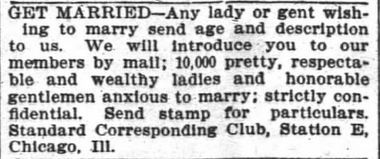
Standard Corresponding Club advertisement in The Atlanta Constitution newspaper, 29 July 1900 and 23 Dec 1900, also Detroit Free Press on 17 June 1900 and St. Louis Dispatch on 10 June 1900.
PUBLIC OPINION
Nineteenth Century American newspapers are rife with articles that both support and praise various marital agencies and point out the perils, disasters, financial losses, broken hearts, and scams. Still, marriage brokers thrived and men and women continued to seek the elusive dream of finding a spouse, love, family, and a lasting connection. Many historically accurate stories portray honest happy-ever-afters while other journal entries speak of miserable outcomes to various mail-order bride pen-pal arrangements.
Let’s speak of the good, first. Happy newlyweds gave glowing reviews and testimonials. Articles in 19th Century newspapers all over the United States spoke of the many successes in bringing lonely hearts together resulting in “conjugal felicity“. (In modern speech: marital happiness/bliss.)
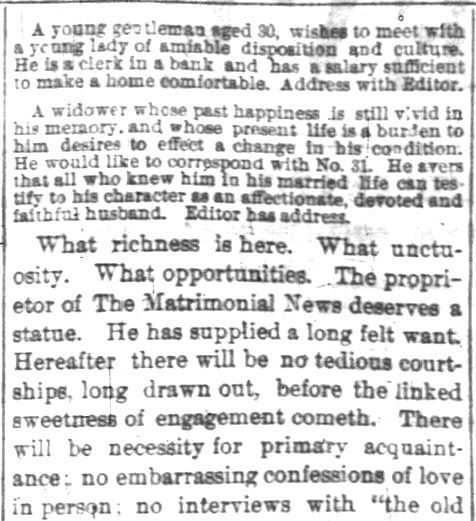
Indianapolis News, 15 Feb 1873. United States advertisements for potential brides and grooms.
![The Indianapolis News Article of 15 February, 1873 CONTINUED. [Image: Courtesy Newspapers.com]](https://i.gr-assets.com/images/S/compressed.photo.goodreads.com/hostedimages/1454702740i/18003018._SY540_.jpg)
The Indianapolis News Article of 15 February, 1873 CONTINUED. [Image: Courtesy Newspapers.com]
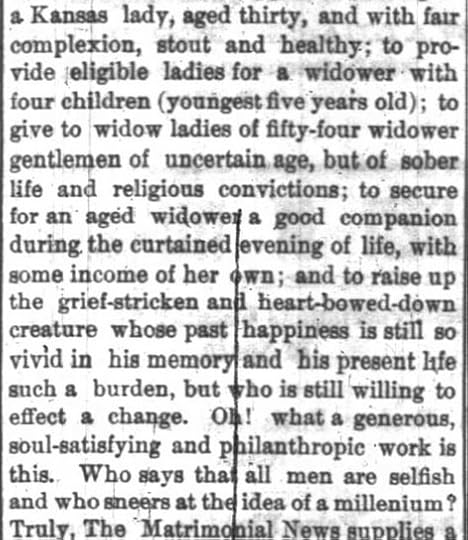
Indianapolis News, continued
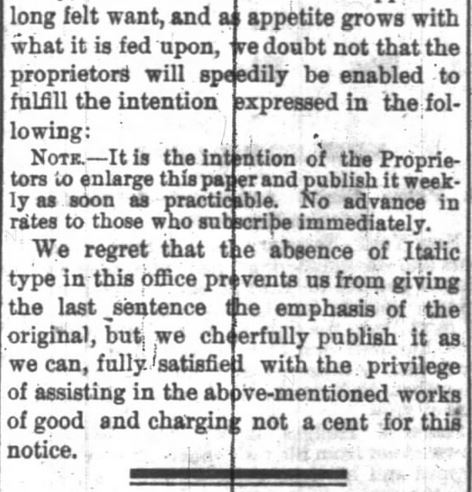
Indianapolis News article, continued to conclusion.
What do you think of using newspapers to connect with a potential partner?
Had you lived in the mid-to-late nineteenth century, would you have dared start a courtship by letter?
I’d love to hear your thoughts! Please leave a reply, and forward this article to anyone else you think might find it enjoyable or informative. Thank you!

Image: Depositphotos, Copyright AnSim, used per standard agreement
My next Article, Nineteenth Century Mail-Order Bride SCAMS, will cover the various historically recorded events showing the dark side of the phenomenon of mail-order brides in the United States. Watch for this shocking show-and-tell to post in approximately three days.
Mail-Order Catalogs: Timeline & Truth Related Article: Mail Order Brides in the 19th Century American West Related Article– Book Review: Hearts West: True Stories of Mail-Order Brides on the Frontier, by Chris Enss
Copyright © 2016 Kristin Holt, LC
.
Kristin Holt's Blog
- Kristin Holt's profile
- 117 followers



